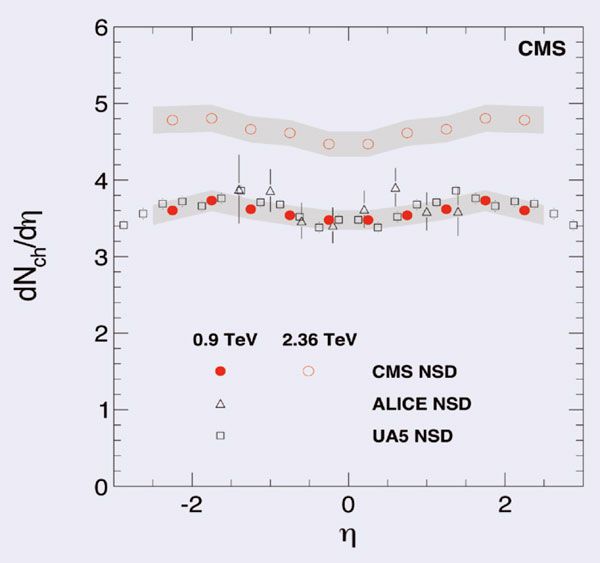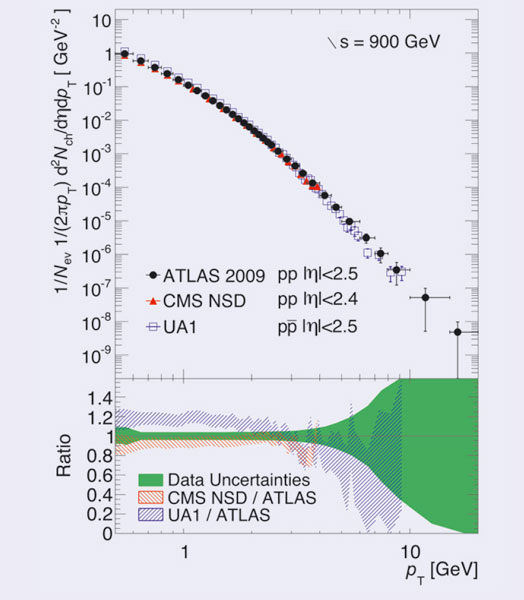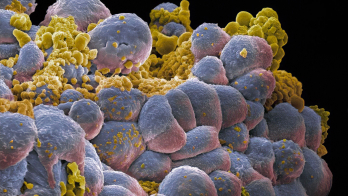
The big LHC experiments have been 20 years in the making; the meeting at which the proto-collaborations first presented their ideas publicly took place in Evian-les-Bains in March 1992. Over the past few years, as the huge and complex apparatus neared completion, they have gathered data from cosmic rays. While this was important for testing and aligning the multilayered detectors, as well as for exercising data-acquisition systems, it was only in November and December last year that the collaborations had their first sight of the long-awaited collisions at the LHC, first at 900 GeV in the centre of mass and then at 2.36 TeV. Collision data at 7 TeV are now beginning to roll in (The LHC’s new frontier). In the meantime the collaborations have been eager to make the most of the data obtained last year and the first LHC physics publications have appeared.
The ALICE collaboration was first off the mark in 2009, with the submission of a paper on the analysis of the 284 events recorded during the first burst of collisions on 23 November. The paper, which presents the measurement of the pseudorapidity density of charged primary particles in the central region at 900 GeV in the centre of mass, was accepted for publication in European Physical Journal C on 3 December (ALICE Collaboration 2010). It compares the measurement on proton–proton collisions at the LHC with those from earlier experiments, including UA1 and UA5 at CERN, which collected data for proton–antiproton collisions at 900 GeV in the centre of mass.
On 4 February the CMS collaboration followed suit with a submission to the Journal of High-Energy Physics, which was refereed and accepted for publication three days later. This paper presents measurements of inclusive charged-hadron transverse-momentum and pseudorapidity distributions for proton–proton collisions at both 900 GeV and 2.36 TeV, based on data collected in December (CMS collaboration 2010). The results at 900 GeV are in agreement with previous measurements (in UA5 and UA1) and in ALICE, and they confirm the expectation of near-equal hadron production in proton–antiproton and proton–proton collisions. The results at 2.36 TeV are in a new high-energy region, however, and they indicate an increase of charged-hadron multiplicity with energy that is steeper than expected.

On 16 March, it was the turn of ATLAS, with a paper submitted to Physics Letters B entitled “Charged-particle multiplicities in pp interactions at √s = 900 GeV measured with the ATLAS detector at the LHC”. This details the collaboration’s first measurements with some 300,000 inelastic events collected in December using a minimum-bias trigger during collisions at 900 GeV (ATLAS collaboration 2010). It presents results for the charged-particle multiplicity, its dependence on transverse momentum and pseudorapidity, and the relationship between mean transverse momentum and charged-particle multiplicity, measured for events with at least one charged particle in the kinematic range η <2.5 and pT> 500 MeV. The results indicate that the charged-particle multiplicity per event and unit of pseudorapidity at η = 0 is some 5–15% higher than the Monte Carlo models predict.
These papers are just the first glimpses of physics at the LHC. To support what is set to be an extensive programme of physics, the LHC Physics Centre at CERN has recently started up. It aims to collect together a variety of initiatives to support the LHC physics programme, from the organization of workshops to the development of physics tools (see http://cern.ch/lpcc).
Further reading
ALICE Collaboration 2010 Eur. Phys. J. C65 111. arXiv:0911.5430
ATLAS Collaboration. arXiv:1003.3124, accepted by Phys. Letts. B
CMS Collaboration. 2010 JHEP 2 041 arXiv:1002.0621v2.








